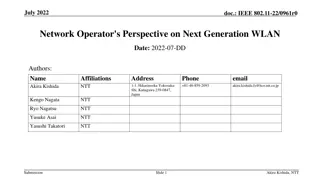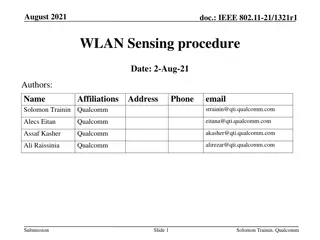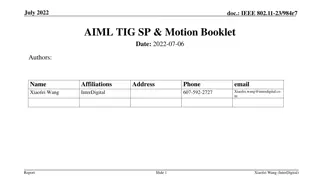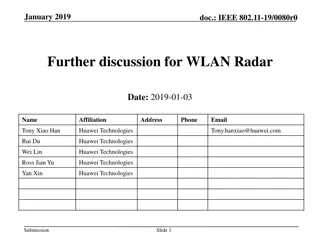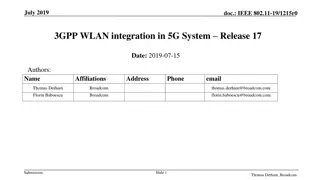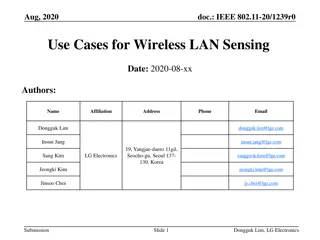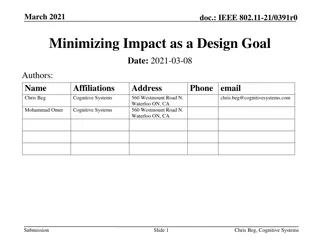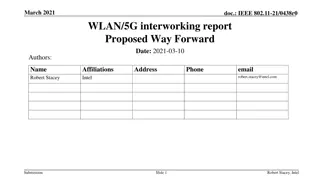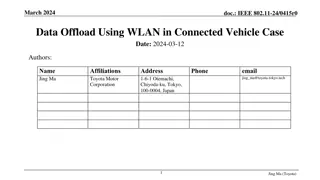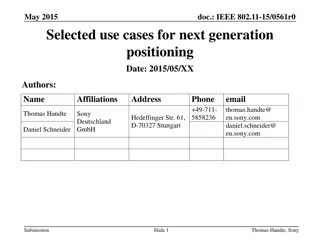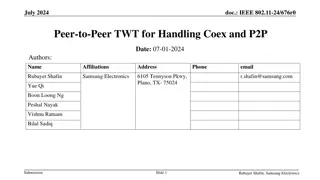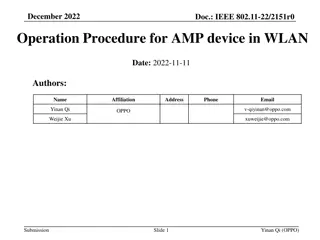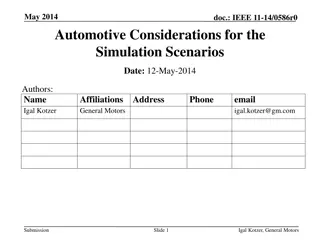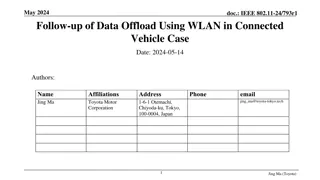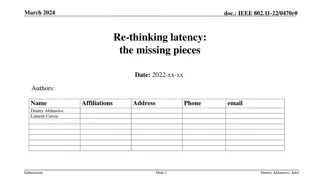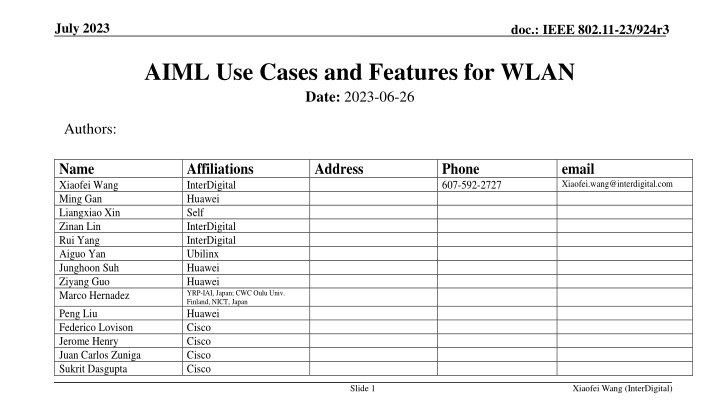
AIML Use Cases and Features for WLAN in IEEE 802.11-23/924r3
Explore the AIML use cases and features for WLAN in the IEEE 802.11-23/924r3 document. Discover how the AIML TIG is working on integrating AIML features into UHR SG and 802.11bn, aiming to enhance IEEE 802.11 systems and devices.
Download Presentation

Please find below an Image/Link to download the presentation.
The content on the website is provided AS IS for your information and personal use only. It may not be sold, licensed, or shared on other websites without obtaining consent from the author. If you encounter any issues during the download, it is possible that the publisher has removed the file from their server.
You are allowed to download the files provided on this website for personal or commercial use, subject to the condition that they are used lawfully. All files are the property of their respective owners.
The content on the website is provided AS IS for your information and personal use only. It may not be sold, licensed, or shared on other websites without obtaining consent from the author.
E N D
Presentation Transcript
July 2023 doc.: IEEE 802.11-23/924r3 AIML Use Cases and Features for WLAN Date: 2023-06-26 Authors: Name Xiaofei Wang Ming Gan Liangxiao Xin Zinan Lin Rui Yang Aiguo Yan Junghoon Suh Ziyang Guo Marco Hernadez Peng Liu Federico Lovison Jerome Henry Juan Carlos Zuniga Sukrit Dasgupta Affiliations InterDigital Huawei Self InterDigital InterDigital Ubilinx Huawei Huawei YRP-IAI, Japan; CWC Oulu Univ. Finland, NICT, Japan Huawei Cisco Cisco Cisco Cisco Address Phone 607-592-2727 email Xiaofei.wang@interdigital.com Slide 1 Xiaofei Wang (InterDigital)
July 2023 doc.: IEEE 802.11-23/924r3 Authors (continued): Name Eunsung Jeon Ziming He Szymon Szott Affiliations Samsung Samsung AGH University of Science and Technology AGH University of Science and Technology UPF Barcelona Address Phone email Katarzyna Kosek-Szott Boris Bellalta Slide 2 Xiaofei Wang (InterDigital)
July 2023 doc.: IEEE 802.11-23/924r3 Abstract The AIML TIG has been working on AIML use cases for IEEE 802.11 systems and devices. This contribution provides an overview of use cases and (by extension) some identified features that the AIML TIG has worked on. Some TIG members expressed desire to integrate AIML use cases and features in UHR SG. Straw polls will be run to gauge UHR SG members interests towards working on AIML related features in UHR and 802.11bn. Slide 3 Xiaofei Wang (InterDigital)
July 2023 doc.: IEEE 802.11-23/924r3 Overview AIML TIG and its mandate AIML TIG goals and activities Highlights of AIML use cases identified for IEEE 802.11 WLANs Summary Straw polls Slide 4 Xiaofei Wang (InterDigital)
July 2023 doc.: IEEE 802.11-23/924r3 AIML TIG and its mandate The AIML TIG is formed by the following WG motion in the July 2022 session [1]: Motion 5: TIG Re: AI/ML use in 802.11 Approve formation of a Topic Interest Group (TIG) to: (a) describe use cases for Artificial Intelligence/Machine Learning (AI/ML) applicability in 802.11 systems and (b) investigate the technical feasibility of features enabling support of AI/ML. The TIG is to complete a report on this topic at or before the March 2023 session. Moved: Stephen McCann, Second: Marc Emmelmann Result: Yes: 119, No: 22, Abstain: 27 (Motion passes) Slide 5 Xiaofei Wang (InterDigital)
July 2023 doc.: IEEE 802.11-23/924r3 AIML TIG Goals and Activities The goals for the AIML TIG are NOT to develop AIML models for the 802.11 specifications The goals and work for the AIML TIG closely follow our mandate Study and describe AIML use cases that are applicable to 802.11 networks Some of the use cases are closely related to what are being considered for UHR/802.11bn With a strong focus on standards impact on IEEE 802.11 specs For each use case, the following aspects are being defined: Standards impact KPIs Requirements Technical feasibility We want to present the use cases to the UHR SG to see whether UHR members are interested in working on these use cases and features Slide 6 Xiaofei Wang (InterDigital)
July 2023 doc.: IEEE 802.11-23/924r3 Highlights of AIML Use Cases Identified for WLANs (1) We highlight in this report AIML use cases that have already been motioned into the AIML TIG Technical Report [2] AIML-based CSI feedback compression/enhancement [3] Deep-learning based distributed channel access [4] Efficient AIML model sharing [5] AIML-based roaming enhancement [6] Additional use cases have been studied and may be included in the technical report AIML-based multi-AP coordination [7] AIML-based dynamic spectrum sharing [8] Slide 7 Xiaofei Wang (InterDigital)
July 2023 doc.: IEEE 802.11-23/924r3 Highlights of AIML Use Cases Identified for WLANs (2) AIML-based CSI Feedback Compression/enhancement [3] Sounding procedures in WLANs represent large overhead particularly with potential new features: Higher number of spatial streams, e.g., 16 Multi-AP features such as joint transmissions Studies show that AIML algorithms may efficiently reduce CSI feedback/improve system throughput using unsupervised learning algorithms to significantly reduce CSI feedback into clusters while maintaining similar PER performance E.g., AIML-aided dual CSI compression combines codebook and Givens Rotation which leverage K-means ML algorithm E.g., AIML algorithm may be used to reduce the computation complexity for CSI feedback, such as quantization of the right singular matrix using an autoencoding-based algorithm Standards impact: Additional signaling (or new signaling design) between AP an STAs required by AIML process to provide (e.g., newly designed) feedback and/or cluster information AIML model sharing (also see AIML Model Sharing Use case) KPIs: CSI airtime reduction/additional AIML process overhead PER Computation complexity/latency Storage needed for AIML models Slide 8 Xiaofei Wang (InterDigital)
July 2023 doc.: IEEE 802.11-23/924r3 Highlights of AIML Use Cases Identified for WLANs (3) Deep-learning based distributed channel access [4] Performances of traditional WLAN channel access designs such as DCF degrade in dense deployment, unable to support stringent QoS requirements such as Ever increasing throughput Low latency Study has shown that deep learning algorithms can efficiently increase throughput and reduce latency and jitter while maintain fairness to other devices E.g., using Deep reinforcement learning for contention window optimization E.g., AIML algorithm selects whether to transmit after the channel has been idle for DIFS Standards impact: Signaling and protocols related to parameter exchange between AP and non-AP STAs, e.g., capability indication, data report to facilitate training, neural networks parameters distribution, etc. KPIs: Throughput improvement Latency and jitter reduction Additional complexity Slide 9 Xiaofei Wang (InterDigital)
July 2023 doc.: IEEE 802.11-23/924r3 Highlights of AIML Use Cases Identified for WLANs (4) Efficient AIML model sharing/distribution [5] Efficient AIML model distribution is essential for many AIML-based operations in WLANs and for performance of WLANs In centralized learning/federated learning, large amount of traffic are used to distribute AIML models/training data among participating devices (STAs and APs), in UL, DL and P2P links Efficient AIML model distribution protocols are needed to enable support AIML operations Including sharing of all AIML models (e.g., for other applications; these model sharing is expected to be carried by WLANs anyway), not just for models used to improve WLAN performance (such as NN models) Efficient AIML model distribution can leverage the broadcast nature of WLANs 802.11bc defines UL/DL broadcast services for both associated and unassociated STAs/APs, providing a good set of baseline tools for AIML model distribution Standards impact: Architecture that enables AIML model sharing on the MAC layer Signaling and protocols related to AIML model sharing support/capability indication and management KPI: medium occupation time saving compared to model sharing using application layer data Slide 10 Xiaofei Wang (InterDigital)
July 2023 doc.: IEEE 802.11-23/924r3 Highlights of AIML Use Cases Identified for WLANs (5) AIML Enhanced Roaming [6] Roaming may occur frequently in dense AP deployments, affecting device battery lifetime and user experience Multi-AP networks commonly see a high level of roaming events A large number of roaming candidate APs/channels in use can cause STA scanning process to take a long time Candidate APs in 802.11k neighbor report are useful, however, not all RF neighbor APs are equally relevant for roaming Efficient AIML techniques may be applied to Augment 802.11k neighbor report with weight for each candidate AP for prioritization of scanning Assist the STA to find the optimal mid-point between APs to start scanning and roam Standards impact: Enhanced 802.11k neighbor report with weight of roaming neighbor AP candidates Triggering STAs to scan at mid-point between APs may require enhancement of BTM request frame Feedback for roaming recommendation by using enhanced BTM response frame KPI: Scanning/Roaming time Roaming failure rate MCS distribution/Retry rate during a BSS transition RSSI at reattach time Slide 11 Xiaofei Wang (InterDigital)
July 2023 doc.: IEEE 802.11-23/924r3 Highlights of AIML Use Cases Identified for WLANs (6) AIML based Multi-AP Transmission [7] In OBSS scenarios, multi-AP coordinated transmissions can improve network performance Multi-AP coordinated transmission is expected to be a feature of UHR SG/802.11bn Configuring such transmissions is challenging due to varying network and radio conditions and outside interference (neighboring, non-coordinating BSS) AIML models can be learnt and help make decisions/predict Find AP-STA pairs, select multi-AP transmission schemes and associated parameters, select when to transmit, etc. Exact multi-AP schemes depend on work in UHR/802.11bn but may include C-TDMA, C-OFDMA, C-SR, C-BF and JT Standards impact: Additional signaling for exchanging training data/measurement reports/model sharing KPI: Network performance metrics (throughput, latency and jitter, power efficiency) measured at the BSS level but also aggregated over the whole multi-AP network Fairness to ensure that all users are fairly served AIML overhead additional signaling, computational complexity, and learning latency Slide 12 Xiaofei Wang (InterDigital)
July 2023 doc.: IEEE 802.11-23/924r3 Highlights of AIML Use Cases Identified for WLANs (7) AIML based Dynamic Spectrum Sharing [8] 802.11 systems operating in dense and high traffic environments, including other 802.11 systems as well as networks that operate using other standards AIML-based solution: spectrum sensing and signal classification infer the presence of other wireless systems sharing the same spectrum, reacting by manipulating 802.11 parameters and techniques according to a given policy under a collaborative or uncollaborative scheme for interference mitigation and avoidance. 802.11 parameters and techniques: key enhancements such as multi-link operation, multi-AP operation, and multiple network allocation vectors, under dense environments require dynamic automation of operations. Standard Impact: AIML requires the specification of the required signaling, data format and protocols of inputs and outputs for AIML models. KPI: Continuous throughput, latency and jitter measured at the MAC-SAP in high density scenarios. Network energy efficiency. Slide 13 Xiaofei Wang (InterDigital)
July 2023 doc.: IEEE 802.11-23/924r3 Summary The AIML TIG s activities closely follow our mandate Study and describe AIML use cases that are applicable to 802.11 networks With a strong focus on standards impact on IEEE 802.11 specs i.e., changes needed to enable/utilize/facilitate AIML operations in 802.11 specs AIML TIG is not developing AIML models The AIML TIG has worked on 6 AIML use cases for WLAN [2][7][8] These use cases are very closely related to those considered for UHR/802.11bn, but will need to require different background knowledge, and hence may require work/effort AIML-based CSI feedback compression/enhancement [3] Deep-learning based distributed channel access [4] Efficient AIML model sharing [5] AIML-based roaming enhancement [6] AIML-based multi-AP coordination [7] AIML-based dynamic spectrum sharing [8] We presented these use cases to gauge the interests of UHR SG members to study/work on these AIML based use cases and features in UHR and 802.11bn Slide 14 Xiaofei Wang (InterDigital)
July 2023 doc.: IEEE 802.11-23/924r3 References [1] 11-22/597r3: May 2022 Working Group Motions, May 18, 2022 [2] 11-22/987r7: AIML TIG Technical Report Draft [3] 11-22/1934r5: Proposed AIML TIG Technical Report Text for the CSI Feedback Compression Use Case [4]11-22/2119r1: Proposed AIML TIG Technical Report Text for the Distributed Channel Access Use Case [5] 11-23/0050r2: Proposed AIML TIG Technical Report Text for the AIML Model Sharing Use Case [6] 11-23/475r4: Proposed IEEE 802.11 AIML TIG Technical Report Text for the AIML-based Roaming Enhancements Use Case [7] 11-23/227r4: Proposed IEEE 802.11 AIML TIG Technical Report Text for the Multi-AP Coordination Use Case [8] 11-23/1072r0: AIML methodology for dynamic spectrum sharing and coexistence Slide 15 Xiaofei Wang (InterDigital)
July 2023 doc.: IEEE 802.11-23/924r3 SP 1 Would you be interested to study/work on AIML related features (as discussed in this presentation) in UHR SG/802.11bn? Yes: No: Abstain: Slide 16 Xiaofei Wang (InterDigital)
July 2023 doc.: IEEE 802.11-23/924r3 SP 2 Which one or more of the following AIML related use case(s)/feature(s) are you interested in working/studying for UHR SG/802.11bn? 1. AIML CSI Feedback compression/enhancement 2. AIML-based distributed channel access 3. AIML model sharing 4. AIML-based roaming enhancement 5. AIML-based multi-AP coordination 6. AIML-based dynamic spectrum sharing Note: Please choose one or more of AIML-based use cases/features Slide 17 Xiaofei Wang (InterDigital)


